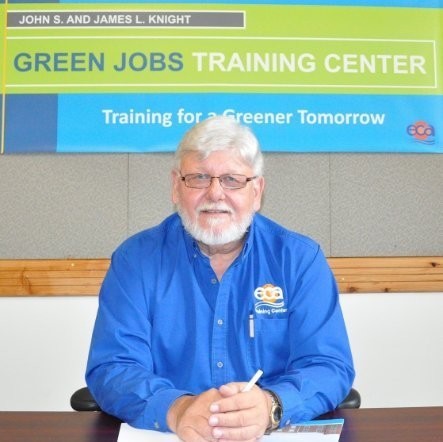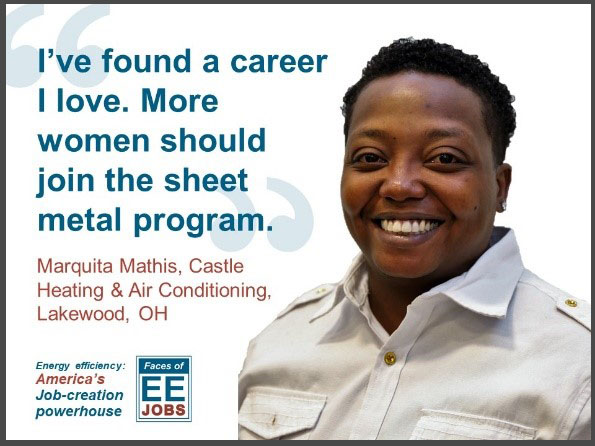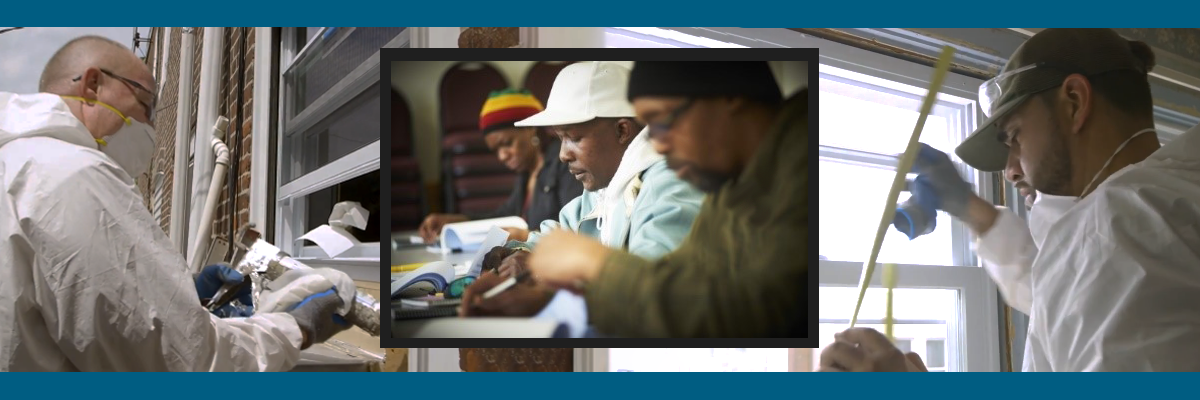by Carina Wallack
“The time to join a fast growing, rewarding career has never been better,” says HVAC professional Chris Morin. “Every home needs these professional skills, most of which do not require a higher education and mountains of debt to attain… [The energy efficiency industry] is a great choice for those interested in a career move to a skill that cannot be outsourced by robotics.”
For those seeking stable jobs with opportunities for social and environmental impact, apprenticeships in the energy efficiency (EE) field are a good option. Energy efficiency professionals are everywhere, with varied roles.
Auditors and technicians may come to mind. But engineers, software developers, architects, and sales representatives also have a place in the industry. EE pros not only help reduce emissions, they also cut customers’ electricity and gas bills and can improve customers’ health and quality of life. Some EE professionals we know cite the ability to help community members as one of the most gratifying aspects of their work. And the sector is growing, with a 7.8% increase in EE jobs predicted in 2019.[1]
Businesses Are Seeking Recruits
Filling jobs is easier said than done, however. About 80% of EE-focused businesses have difficulty finding skilled workers. As current EE workers approach retirement age, young aspiring professionals entering the field can reinvigorate this vital sector of the economy.
Industry — and military — veteran Chris Morin, who I was lucky to interview, notes that “over the last 10 years, we have seen a labor shortage in most service trades. Simply finding a new employee who wants to learn the industry is a challenge.” Chris feels apprenticeships are part of the solution. A placement can enable the apprentice to try out the industry, while the business can see if the person is a good fit to fully employ.
What is an Apprenticeship?
For young people or those new to the industry, apprenticeships can provide a great opportunity. Across all industries, more than 150,000 U.S. employers in 1,000 occupations offer apprenticeships.[2] Such programs are registered at either the U.S. Department of Labor, or at a state’s Department of Labor and Industry. Most are administered at the state level. Some apprenticeships are connected to trade unions while others are subsidized by workforce development agencies or private foundations.
The U.S. Department of Labor requires that apprentices complete a minimum of 144 hours of classroom training and 2000 hours of on-the-job training.[3] In certain states, companies that offer apprenticeship programs are eligible for tax credits.[4] Employers may also be able to claim some training expenses as a federal tax credit.[5]
Unlike some internships, apprenticeships are always paid; apprentices must be employed. Apprentices are paired with a supervisor called a journeyperson. Typically, three apprentices are assigned to each journeyperson. Small companies that can’t necessarily sustain their own apprenticeship programs can still reap the benefits of existing apprenticeships — they can collaborate with workforce development agencies to connect with qualified professionals.
Insight from Industry Leaders

Chris Morin is a U.S. Marines veteran, a blogger, and an Area Manager at Mitsubishi Electric Cooling & Heating

Ryan Rex, Director of Conservation at the Energy Coordinating Agency

Walter Yakabosky, Director of Training at the Energy Coordinating Agency
EE Pros
I spoke with Ryan Rex and Walter Yakabosky at Philadelphia’s Energy Coordinating Agency (ECA) to learn about their apprenticeship program. To meet new carbon reduction goals, Pennsylvania recently released a Climate Action Plan proposing incentives for efficient buildings. EE workers will be in high demand. ECA’s apprenticeship program is funded by the city, state, and foundations. All apprentices at ECA are full-time employees. Many of their apprentices continue to work for ECA upon completion of the program.
“Apprenticeships are for everyone,” explains Ryan. While many apprentices are recent high school graduates, programs cater to anyone wishing to join the EE workforce. Apprenticeships also provide opportunities to veterans and to individuals reentering society. ECA employs several previously incarcerated individuals; Ryan says that one was among his most successful apprentices and is now a journeyperson.
Apprenticeships benefit those new to the EE industry and they make good sense for companies. Ryan and Walt feel that the majority of qualified people are already employed, so it is best to train new employees. As Ryan says, “if any company or organization wants to ensure they have a highly trained workforce, they should set up an apprenticeship program.”
Walt explains that job candidates who have earned credentials may lack hands-on experience. Apprenticeships teach necessary skills, with each journeyperson providing constant feedback. Apprentices learn by doing, and supervisors can make corrections at every step of a project.
Apprenticeships extend beyond advanced technical skills. “Soft skills” can be equally important. Promptness, the ability to connect with customers, and an awareness of cultural nuances that affect communication are all crucial to success. As Ryan and Walter point out, these skills can’t be learned in a classroom.

Jeff Coulter on the job. Jeff joined ECA as an apprentice and is now a journeyperson.

Marquita Mathis joined Castle Heating and Air Conditioning as an apprentice.
With the obvious benefits for companies, professionals, and the industry, we need more EE apprentices to mitigate widespread hiring difficulties. We need to make apprenticeships available to those who face barriers to employment. The Aspen Institute points out that attributes typically seen as obstacles may be assets to apprentices e.g., speaking a language other than English, or a history of caring for a family member with a health problem or disability. This is especially true where workers need to communicate with non-native English speakers and implement solutions for occupants with health issues and disabilities. The Aspen authors see that these skills may be just as valuable as technical skills.
As the success of ECA’s program demonstrates, designing programs with a focus on equity allows people with diverse backgrounds and experiences to join the ranks of EE pros and makes the industry stronger for everyone.
Recruiting young people is beneficial. Ryan explains that pre-apprenticeship programs beginning as early as ninth grade can be effective. Pre-apprenticeship programs can provide high school students with summer internships. They can lead directly into apprenticeships for graduates, who can get advanced training without incurring debt. Several programs are doing exactly that. The Sheet Metal and Air Conditioning Contractors Association of Milwaukee (SMACCA Milwaukee) offers a Youth Apprentice program as part of Wisconsin’s School-to-Work initiative. And the Cleveland Metropolitan School District began a school-to-apprenticeship program in 2018 that places students with companies that are members of the Sheet Metal and Air Conditioning Contractors’ National Association (SMACNA).
Chris notes that it’s also important to spread awareness about the variety of jobs: “If only our students understood the opportunity in the multiple energy efficiency fields,” he says. “These jobs aren’t just crawling around attics, but also using diagnostic technology to provide year-round comfort to the majority of Americans!”
We need to spread the word to potential apprentices wherever we may find them. As Walt says, when marketing these programs “we need a bigger microphone with more watts.” Please join us in boosting the signal about EE apprenticeships. Policies that support rapid growth in the EE workforce are vital to reducing emissions and maintaining the strength of the industry for years to come.
–Carina Wallack is a Policy Associate at E4TheFuture
